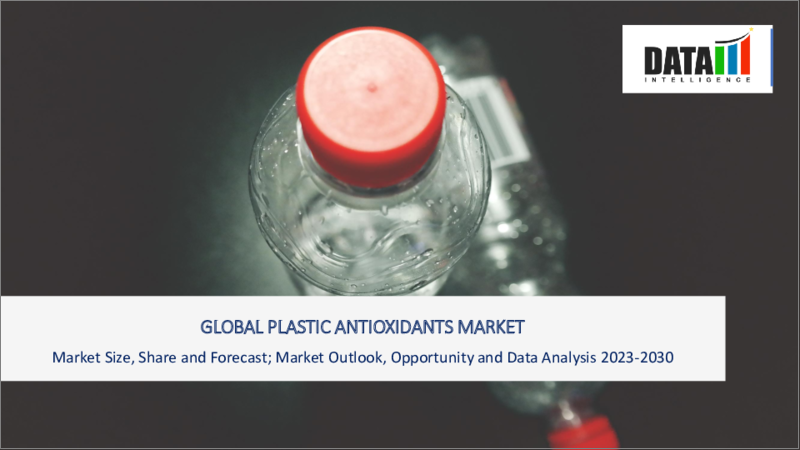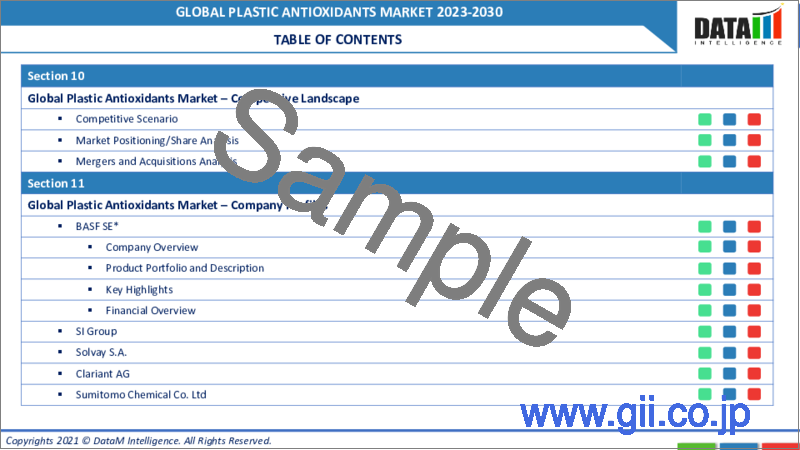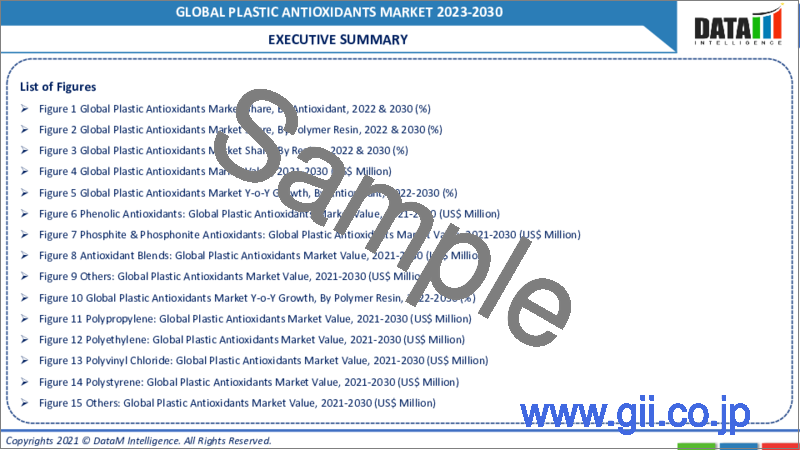|
|
市場調査レポート
商品コード
1176616
プラスチック酸化防止剤の世界市場-2023-20230Global Plastic Antioxidants Market - 2023-20230 |
||||||
|
● お客様のご希望に応じて、既存データの加工や未掲載情報(例:国別セグメント)の追加などの対応が可能です。 詳細はお問い合わせください。 |
|||||||
| プラスチック酸化防止剤の世界市場-2023-20230 |
|
出版日: 2022年12月26日
発行: DataM Intelligence
ページ情報: 英文 202 Pages
納期: 約2営業日
|
- 全表示
- 概要
- 目次
市場概要
プラスチック酸化防止剤の世界市場は、予測期間(2023-2030年)にCAGR5.50%で成長することで大きな成長を記録すると予測されています。
ポリマーは時間の経過とともに劣化・分解し、流動性、熱安定性、分子量などの物理的・機械的品質に影響を及ぼします。ポリマーの熱酸化を抑えるために、酸化防止剤が生み出されてきました。ポリマーでは、酸化防止剤がフリーラジカルやヒドロペルオキシド中間体の発生を防止します。プラスチックは、金属、ガラス、紙、セラミックスと同じ機械的・電気的品質と耐摩耗性・耐薬品性を持っています。一部の産業で軽量化の技術革新が続き、さらなる軽量化素材が求められた結果、プラスチック、ガラス、紙、セラミックを包装、建設、自動車産業で使用することになりました。これらの酸化防止剤をプラスチックに添加することで、日光や熱に対する耐性が高まります。
酸化防止剤とは、プラスチックの製造に使用される化合物です。熱機械的および熱酸化的な条件による劣化を防ぐために、プラスチックに適用されます。酸化防止剤は、色調の劣化、引張強度と伸びの増加、衝撃強度の低下、割れなどの表面劣化の減少により、プラスチックの寿命を延ばすのに役立っています。プラスチック酸化防止剤の主な種類は一次酸化防止剤と二次酸化防止剤で、熱的に安定したプラスチック製品を作るために一次酸化防止剤と二次酸化防止剤を混合することがよくあります。また、一次酸化防止剤と二次酸化防止剤を併用することで、プラスチック製造時の加工安定性を向上させることができます。
市場力学
自動車、消費財、建築・建設、医療・ヘルスケアなどの業界において、PE、PP、PVC、PSなどのポリマー樹脂用のプラスチック酸化防止剤の需要が増加していることが、市場を牽引しています。従来の材料に代わるプラスチック、医療需要の増加、新興国での都市化の進展が、プラスチック酸化防止剤市場を牽引します。
様々な最終用途産業における高性能プラスチックへの需要の高まり
フェノール系酸化防止剤は、一般的にプラスチックやゴムの製造に成分として使用されています。プラスチックは、その優れた特性から、さまざまな産業で加速度的に使用されています。プラスチック添加剤は、プラスチック製品の劣化を遅らせたり制限したりするため、高温・高圧などの厳しい環境下での効力や作業性を向上させるために使用されています。
フェノール系酸化防止剤は、過酷な条件下でのポリマー製品の酸化を防止するため、ポリマー製造における酸化防止剤に採用されています。さらに、自動車産業における総重量削減のためのプラスチック使用の増加は、プラスチック添加剤の需要を増加させるでしょう。これは、予測期間中にフェノール系酸化防止剤の需要を高めるでしょう。
他の材料に対するプラスチックへの嗜好の高まり
酸化防止剤は、PE、PP、PVCなど、さまざまなポリマーに使用されています。これらのプラスチックは、包装、建築・建設、自動車を含む様々な産業で利用されています。プラスチックは、機械的・電気的特性、耐摩耗性、耐薬品性の面で、金属、ガラス、紙、セラミックなどの従来の材料よりも優れています。パッケージング、建築・建設、自動車の各業界では、技術革新が進み、より軽量な材料が必要とされているため、金属、ガラス、紙、セラミックスに代わって、プラスチックが使用されています。プラスチック酸化防止剤業界を活性化させると予測されています。
プラスチックは、自動車産業、特に自動車の設計において、安全性、燃費、性能の大幅な向上に寄与してきました。例えば、高強度ポリマー繊維で構成されたエアバッグは、自動車の前面衝突で致命的な損傷を受ける可能性を低くすることができます。また、チャイルドシート、ルーフライニング、ステアリングホイール、ダッシュボード、フェンダー、燃料システム、ヘッドランプカバーなど、熱や光にすぐにさらされる外装部分への応用も進んでいます。
合成樹脂酸化防止剤の健康への有害性
プラスチックは、その構造を維持し、熱的に安定させるために酸化防止剤で処理されます。PPやHDPEなどのポリマーに多用されている2,6ジ-tert-ブチル-p-クレゾール(BHT)などの合成酸化防止剤は、人体に有害であることが分かっています。ある研究によると、BHTは実験動物に突然変異やガン、内分泌系の影響を与えます。また、人のアレルギー反応も誘発します。LDPE、HDPE、PPボトルからは、測定可能なレベルのBHT、Chimassorb 81、Irganox PS 800、Irganox 1076、Irganox 1010が食品の中身に漏れ出すことも実証されています。
酸化防止剤の健康への影響には、がんの原因となる内分泌障害、子供の発育障害、先天性奇形、免疫系の抑制などがあります。酸化防止剤を含むプラスチックは、様々な日用品、自動車部品、食品包装、建材を製造しています。これらの有害成分は、プラスチックから人体へ浸出します。健康に悪影響を及ぼすため、フェノール系酸化防止剤の需要は減少しています。
COVID-19の影響分析
世界の流行は、地球上の実質的にすべての産業に影響を及ぼしています。政府機関は、予防および治療用医薬品の開発、重要な医療機器の獲得、診断テストの承認の迅速化に対して特別な財政支援を宣言しています。2020年のCOVID-19の流行は、世界中の多数のビジネスに大混乱をもたらしました。自動車、建築・建設、消費財、包装などの最終用途産業からのプラスチック需要の減少により、プラスチックの加工に必要な添加物、特にプラスチック酸化防止剤の需要が減少しました。
2020年以降に産業が開放されたが、限られた人員で、2020年までに完全に稼働すると予測されます。このようなことを考慮すると、プラスチック酸化防止剤市場は2020年にはマイナス成長となり、その後予測年中にプラス成長で回復すると思われます。
目次
第1章 プラスチック酸化防止剤の世界市場の調査手法と範囲
- 調査手法
- 調査目的および調査範囲
第2章 プラスチック酸化防止剤の世界市場-市場の定義と概要
第3章 プラスチック酸化防止剤の世界市場- エグゼクティブサマリー
- 酸化防止剤別の市場内訳
- 高分子樹脂別市場内訳
- 地域別市場内訳
第4章 プラスチック酸化防止剤の世界市場-市場力学
- 市場影響因子
- 促進要因
- 様々な最終用途産業における高性能プラスチックへの需要拡大
- 他の材料に対するプラスチックへの嗜好の高まり
- 抑制要因
- 合成プラスチック酸化防止剤の健康への有害な影響
- ビジネスチャンス
- 影響分析
- 促進要因
第5章 プラスチック酸化防止剤の世界市場-産業分析
- ポーターのファイブフォース分析
- サプライチェーン分析
- 価格設定分析
- 規制分析
第6章 プラスチック酸化防止剤の世界市場-COVID-19分析
- COVID-19の市場分析
- COVID-19市場参入前のシナリオ
- COVID-19の現在の市場シナリオ
- COVID-19の後、または将来のシナリオ
- COVID-19の中での価格ダイナミクス
- 需要-供給スペクトラム
- パンデミック時の市場に関連する政府の取り組み
- メーカーの戦略的な取り組み
- まとめ
第7章 プラスチック酸化防止剤の世界市場- 酸化防止剤別
- フェノール系酸化防止剤
- 亜リン酸塩系酸化防止剤・亜リン酸塩系酸化防止剤
- 酸化防止剤ブレンド
- その他
第8章 プラスチック酸化防止剤の世界市場- 高分子樹脂別
- ポリプロピレン
- ポリエチレン
- ポリ塩化ビニル
- ポリスチレン
- その他
第9章 プラスチック酸化防止剤の世界市場- 地域別
- 北米
- 米国
- カナダ
- メキシコ
- 欧州
- ドイツ
- 英国
- フランス
- イタリア
- スペイン
- その他欧州
- 南米
- ブラジル
- アルゼンチン
- その他の南米地域
- アジア太平洋地域
- 中国
- インド
- 日本
- オーストラリア
- その他アジア太平洋地域
- 中東とアフリカ
第10章 プラスチック酸化防止剤の世界市場- 競争情勢
- 競合シナリオ
- 市況分析/シェア分析
- M&A(合併・買収)分析
第11章 プラスチック酸化防止剤の世界市場-企業プロファイル
- BASF SE
- 企業概要
- 製品ポートフォリオと説明
- 主なハイライト
- 財務概要
- SI Group
- Solvay S.A.
- Clariant AG
- Sumitomo Chemical Co. Ltd
- Astra Polymers
- Everspring Chemical Co. Ltd
- Dover Chemical Corporation
- SONGWON
- Ampacet Corporation
第12章 プラスチック酸化防止剤の世界市場- 重要考察
第13章 プラスチック酸化防止剤の世界市場-DataM
Market Overview
The global plastic antioxidants market reached US$ XX million in 2022 and is expected to record significant growth by reaching up to US$ XX million by 2030, growing at a CAGR of 5.50% during the forecast period (2023-2030).
Polymers degrade and break down over time, influencing physical and mechanical qualities such as flow rate, heat stability and molecular weight. To reduce the heat oxidation of polymers, antioxidants have been created. In polymers, antioxidants prevent the generation of free radicals and hydroperoxide intermediates. Plastics have the same mechanical & electrical qualities and abrasion & chemical resistance as metals, glass, paper and ceramics. Continuous lightweight innovation in some industries and the desire for additional lightweight materials resulted in using plastic, glass, paper and ceramic in packaging, construction and the automotive industry. Adding these antioxidants to the plastic increases its resistance to sunshine and heat.
Antioxidants are compounds used in the manufacture of plastic. They are applied to plastic to prevent degradation caused by thermomechanical and thermooxidative conditions. Antioxidants aid in extending the life of plastic by increasing color deterioration, providing tensile strength and elongation and reducing impact strength, cracking and other surface deterioration. Primary and secondary antioxidants are the principal types of plastic antioxidants and primary plastic is frequently mixed with secondary to generate thermally stable plastic products. Furthermore, combining primary and secondary antioxidants improves processing stability during plastic manufacture.
Market Dynamics
The increased demand for plastic antioxidants for polymer resins such as PE, PP, PVC, PS and others in industries such as automotive, consumer goods, building & construction and medical & healthcare is driving the market. Plastics replacing traditional materials, rising medical demand and increased urbanization in developing nations will drive the plastic antioxidants market.
The growing demand for high-performance plastics across various end-use industries
Phenolic antioxidants are commonly used as an ingredient in the manufacture of plastics and rubber. Plastic is being used at an accelerating rate in various industries due to its outstanding characteristics. Plastic additives are used to improve efficacy and workability in tough settings such as high-temperature and high-pressure situations because they slow down or limit the degradation of plastic products.
Phenolic antioxidants are employed as antioxidant additives in polymer manufacturing because they prevent the oxidation of polymeric goods in hostile conditions. Furthermore, the growing use of plastic in the automobile industry to lower total weight will drive up demand for plastic additives. It will enhance phenolic antioxidant demand over the projection period.
Rising preference for plastics over other materials
Antioxidants are employed in various polymers, including PE, PP and PVC. These plastics are utilized in various industries, including packaging, building & construction and automotive. Plastics outperform traditional materials such as metals, glass, paper and ceramics in terms of mechanical and electrical characteristics, abrasion resistance and chemical resistance. Plastics have replaced metals, glass, paper and ceramics in the packaging, building & construction and automotive industries due to ongoing innovation and the need for more lightweight materials. It is projected to fuel the plastic antioxidants industry.
Plastics have contributed to significant advancements in safety, fuel efficiency and performance in the automotive industry, particularly in automobile design. For example, airbags composed of high-strength polymer fabric can lower the chance of fatal injury in a direct, frontal car crash. Child safety seats, roof linings, steering wheels, dashboards, fenders, fuel systems, headlamp covers and other exterior sections that are immediately exposed to heat and light are among the other developments.
Hazardous health effects of synthetic plastic antioxidants
Plastics are treated with antioxidants to maintain their structure and make them more thermally stable. Synthetic antioxidants, such as 2,6 di-tert-butyl-p-cresol (BHT), extensively employed in polymers such as PP and HDPE, are harmful to human health. According to one study, BHT produces mutations, cancers and endocrine consequences in test animals. It also triggers allergic reactions in people. LDPE, HDPE and PP bottles have also been demonstrated to leak measurable levels of BHT, Chimassorb 81, Irganox PS 800, Irganox 1076 and Irganox 1010 into the food contents.
The antioxidants' health impacts include endocrine disturbance, which can lead to cancer, developmental issues in children, congenital deformities and immune system suppression. Plastics containing antioxidants make various household goods, automotive parts, food packaging and building materials. These hazardous components leach from the plastic and into the human body. The demand for phenolic antioxidants is falling due to their negative health impacts.
COVID-19 Impact Analysis
The global epidemic has affected practically every industry on the planet. Government agencies have declared particular financial assistance for developing preventive and curative pharmaceuticals, acquiring critical care medical devices and expediting diagnostic test approval. The COVID-19 epidemic in 2020 wreaked havoc on numerous businesses around the world. The decline in demand for plastics from end-use industries such as automotive, building and construction, consumer products and packaging has resulted in a fall in demand for additives required to process plastics, particularly plastic antioxidants.
Industries opened up after 2020 but with limited staff and are projected to be fully operational by 2020. Given the considerations, the plastic antioxidants market will likely see negative growth in 2020 before rebounding with positive growth during the forecast year.
Segment Analysis
By polymer resin, the plastic antioxidants market is segmented into polypropylene, polyethylene, polyvinyl chloride, polystyrene and others.
The increasing use of polypropylene in packaging
Plastic antioxidants are additives introduced throughout manufacturing to prevent thermal and oxidative degradation and extend product shelf life. Plastic antioxidants are expected to be used the most in polypropylene polymer resin throughout the forecast period, owing to the rising use of polypropylene in the packaging industry, which is expected to drive the plastic antioxidant market.
Polypropylene is a thermoplastic polymer containing tertiary carbon atoms. Because it contains tertiary carbon atoms, it is prone to oxidation and thermal deterioration at high temperatures. Polypropylene is treated at temperatures ranging from 428°F to 536°F, where it degrades to generate low molecular weight compounds. To stabilize Polypropylene, antioxidants are added. Antioxidants are included during palletizing and manufacturing process.
Butylated hydroxyl-toluene (BHT), a primary antioxidant and phosphite and phosphonite, secondary antioxidants, are PP's most often utilized antioxidants. Polypropylene resins are also employed in heavy-duty sacks, hygiene films, compounding and other applications, which increases the need for polypropylene and results in the demand for plastic antioxidants.
Geographical Analysis
The rising usage of resins in various end-use industries in Asia-Pacific
Asia-Pacific is estimated to hold the largest plastic antioxidants market during the projected period. Plastic antioxidants are in high demand in countries such as China and India, owing to the rising use of various resins in various end-user sectors such as electrical & electronics, automotive and oil & gas.
Polyethylene and polypropylene resins are in high demand in the construction and building industries because of their thermal and oxidation resistance qualities. The region's growing urbanization and industrialization are driving up the demand for plastic antioxidants even more. The phenolic antioxidant type slows the oxidation of organic matter by transferring hydrogen atoms from their OH group to the chain carrying the ROO radical. Due to this, it is frequently utilized as a plastic additive in polyolefin and other plastic types.
Furthermore, due to features such as high tensile strength, stiffness and flexibility, acrylonitrile butadiene styrene resin is expected to rise significantly throughout the projected period, owing to its use in various end-user industries. Asia-Pacific construction industry is expected to grow at a healthy CAGR throughout the forecast period, which may result in high demand for polyethylene and polypropylene resins, raising demand for the region's plastic antioxidant market.
BASF SE, SONGWON and Solvay are some of the biggest corporations operating in Asia-Pacific. Furthermore, government backing and a fast-rising industrial base will likely increase the demand for plastic antioxidants during the projection period.
Competitive Landscape
The global plastic antioxidants market is fragmented, with the top five market players expected to control most of the market share. The phenolic antioxidants market has seen substantial growth in the last few years. Key players' chosen tactics for sustaining and expanding the worldwide phenolic antioxidants market include new product development, acquisitions and capacity expansion.
Songwon Industrial Co. Ltd. began producing phenolic antioxidants in Panoli (Gujarat), India, in 2018.
BASF opened the second phase of its new antioxidant manufacturing factory in Shanghai, China, in December 2019 to service the country's rapidly developing antioxidants market.
Major global plastic antioxidants market companies include: BASF SE, SI Group, Solvay S.A., Clariant AG, Sumitomo Chemical Co. Ltd, Astra Polymers, Everspring Chemical Co. Ltd, Dover Chemical Corporation, SONGWON and Ampacet Corporation.
BASF SE
- Overview: BASF, located in Germany, is one of the world's largest chemical manufacturers. Its offering comprises chemicals, materials, industrial solutions, surface technology, nutrition & care and agricultural solutions. It provides various system solutions, services and products for the chemical, automotive, construction, agriculture, oil, plastics, electrical, electronics, furniture and paper industries. The 11 divisions are divided into six parts based on their business models. They oversee 50 global and regional business units and 75 strategic business units.
- Product Portfolio: BASF manufactures antioxidants for plastics. Its Irganox® series contains the most antioxidants for usage in organic substrates such as plastics, synthetic fibers and elastomers. In a wide range of applications, Irganox® ensures long-term thermal and process stability. Irganox® branded antioxidants are provided globally, giving the polymer value chain the necessary stabilization, manufacturing flexibility and supply security. BASF experts are present worldwide to determine the best Irganox® antioxidant for any application. BASF also offers customer-specific blends (CSBs) made from extruded or compacted combinations of Irganox® antioxidants and additional additives.
- Key Development: BASF increased the manufacturing capacity of its antioxidant Irganox® 1010 at its Jurong Island, Singapore, plant in 2022 by incorporating an extra production line into the present production facilities. BASF's capacity expansion gives its clients more flexibility and assures supply reliability. The expanded capacity in Singapore will primarily service the rapidly rising Asia Pacific and Middle East markets.
Why Purchase the Report?
- Visualize the composition of the plastic antioxidants market segmentation by antioxidant, polymer resin and region, highlighting the critical commercial assets and players.
- Identify commercial opportunities in the plastic antioxidants market by analyzing trends and co-development deals.
- Excel data sheet with thousands of plastic antioxidants market-level 4/5 segmentation points.
- Pdf report with the most relevant analysis cogently put together after exhaustive qualitative interviews and in-depth market study.
- Product mapping in excel for the key product of all major market players
The global plastic antioxidants market report would provide access to an approx. 53 market data table, 42 figures and 202 pages.
Target Audience 2022
- Plastic Antioxidants Service Providers/ Buyers
- Industry Investors/Investment Bankers
- Education & Research Institutes
- Emerging Companies
- Plastic Antioxidants Manufacturers
Table of Contents
1. Global Plastic Antioxidants Market Methodology and Scope
- 1.1. Research Methodology
- 1.2. Research Objective and Scope of the Report
2. Global Plastic Antioxidants Market - Market Definition and Overview
3. Global Plastic Antioxidants Market - Executive Summary
- 3.1. Market Snippet By Antioxidant
- 3.2. Market Snippet By Polymer Resin
- 3.3. Market Snippet By Region
4. Global Plastic Antioxidants Market-Market Dynamics
- 4.1. Market Impacting Factors
- 4.1.1. Drivers
- 4.1.1.1. The growing demand for high-performance plastics across various end-use industries
- 4.1.1.2. Rising preference for plastics over other materials
- 4.1.2. Restraints
- 4.1.2.1. Hazardous health effects of synthetic plastic antioxidants
- 4.1.2.2. XX
- 4.1.3. Opportunity
- 4.1.3.1. XX
- 4.1.4. Impact Analysis
- 4.1.1. Drivers
5. Global Plastic Antioxidants Market - Industry Analysis
- 5.1. Porter's Five Forces Analysis
- 5.2. Supply Chain Analysis
- 5.3. Pricing Analysis
- 5.4. Regulatory Analysis
6. Global Plastic Antioxidants Market - COVID-19 Analysis
- 6.1. Analysis of COVID-19 on the Market
- 6.1.1. Before COVID-19 Market Scenario
- 6.1.2. Present COVID-19 Market Scenario
- 6.1.3. After COVID-19 or Future Scenario
- 6.2. Pricing Dynamics Amid COVID-19
- 6.3. Demand-Supply Spectrum
- 6.4. Government Initiatives Related to the Market During Pandemic
- 6.5. Manufacturers Strategic Initiatives
- 6.6. Conclusion
7. Global Plastic Antioxidants Market - By Antioxidant
- 7.1. Introduction
- 7.1.1. Market Size Analysis and Y-o-Y Growth Analysis (%), By Antioxidant
- 7.1.2. Market Attractiveness Index, By Antioxidant
- 7.2. Phenolic Antioxidants*
- 7.2.1. Introduction
- 7.2.2. Market Size Analysis and Y-o-Y Growth Analysis (%)
- 7.3. Phosphite & Phosphonite Antioxidants
- 7.4. Antioxidant Blends
- 7.5. Others
8. Global Plastic Antioxidants Market - By Polymer Resin
- 8.1. Introduction
- 8.1.1. Market Size Analysis and Y-o-Y Growth Analysis (%), By Polymer Resin
- 8.1.2. Market Attractiveness Index, By Polymer Resin
- 8.2. Polypropylene*
- 8.2.1. Introduction
- 8.2.2. Market Size Analysis and Y-o-Y Growth Analysis (%)
- 8.3. Polyethylene
- 8.4. Polyvinyl Chloride
- 8.5. Polystyrene
- 8.6. Others
9. Global Plastic Antioxidants Market - By Region
- 9.1. Introduction
- 9.2. Market Size Analysis and Y-o-Y Growth Analysis (%), By Region
- 9.3. Market Attractiveness Index, By Region
- 9.4. North America
- 9.4.1. Introduction
- 9.4.2. Key Region-Specific Dynamics
- 9.4.3. Market Size Analysis and Y-o-Y Growth Analysis (%), By Antioxidant
- 9.4.4. Market Size Analysis and Y-o-Y Growth Analysis (%), By Polymer Resin
- 9.4.5. Market Size Analysis and Y-o-Y Growth Analysis (%), By Country
- 9.4.5.1. U.S.
- 9.4.5.2. Canada
- 9.4.5.3. Mexico
- 9.5. Europe
- 9.5.1. Introduction
- 9.5.2. Key Region-Specific Dynamics
- 9.5.3. Market Size Analysis and Y-o-Y Growth Analysis (%), By Antioxidant
- 9.5.4. Market Size Analysis and Y-o-Y Growth Analysis (%), By Polymer Resin
- 9.5.5. Market Size Analysis and Y-o-Y Growth Analysis (%), By Country
- 9.5.5.1. Germany
- 9.5.5.2. UK
- 9.5.5.3. France
- 9.5.5.4. Italy
- 9.5.5.5. Spain
- 9.5.5.6. Rest of Europe
- 9.6. South America
- 9.6.1. Introduction
- 9.6.2. Key Region-Specific Dynamics
- 9.6.3. Market Size Analysis and Y-o-Y Growth Analysis (%), By Antioxidant
- 9.6.4. Market Size Analysis and Y-o-Y Growth Analysis (%), By Polymer Resin
- 9.6.5. Market Size Analysis and Y-o-Y Growth Analysis (%), By Country
- 9.6.5.1. Brazil
- 9.6.5.2. Argentina
- 9.6.5.3. Rest of South America
- 9.7. Asia-Pacific
- 9.7.1. Introduction
- 9.7.2. Key Region-Specific Dynamics
- 9.7.3. Market Size Analysis and Y-o-Y Growth Analysis (%), By Antioxidant
- 9.7.4. Market Size Analysis and Y-o-Y Growth Analysis (%), By Polymer Resin
- 9.7.5. Market Size Analysis and Y-o-Y Growth Analysis (%), By Country
- 9.7.5.1. China
- 9.7.5.2. India
- 9.7.5.3. Japan
- 9.7.5.4. Australia
- 9.7.5.5. Rest of Asia-Pacific
- 9.8. Middle East and Africa
- 9.8.1. Introduction
- 9.8.2. Key Region-Specific Dynamics
- 9.8.3. Market Size Analysis and Y-o-Y Growth Analysis (%), By Antioxidant
- 9.8.4. Market Size Analysis and Y-o-Y Growth Analysis (%), By Polymer Resin
10. Global Plastic Antioxidants Market - Competitive Landscape
- 10.1. Competitive Scenario
- 10.2. Market Positioning/Share Analysis
- 10.3. Mergers and Acquisitions Analysis
11. Global Plastic Antioxidants Market - Company Profiles
- 11.1. BASF SE
- 11.1.1. Company Overview
- 11.1.2. Product Portfolio and Description
- 11.1.3. Key Highlights
- 11.1.4. Financial Overview
- 11.2. SI Group
- 11.3. Solvay S.A.
- 11.4. Clariant AG
- 11.5. Sumitomo Chemical Co. Ltd
- 11.6. Astra Polymers
- 11.7. Everspring Chemical Co. Ltd
- 11.8. Dover Chemical Corporation
- 11.9. SONGWON
- 11.10. Ampacet Corporation
LIST NOT EXHAUSTIVE
12. Global Plastic Antioxidants Market - Premium Insights
13. Global Plastic Antioxidants Market - DataM
- 13.1. Appendix
- 13.2. About Us and Services
- 13.3. Contact Us




